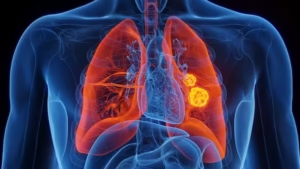
Aug 8, 2025 13:03 IST
First published on: Aug 8, 2025 at 13:03 IST
The Global Cancer Observatory’s India Factsheet 2022 puts lung cancer as the second-leading cause of cancer among men in the country, accounting for 8.5 per cent of all cancers. It accounted for nearly 82,000 new lung cancer cases in the year and was the fourth largest cause across both men and women. In terms of an age-standardised rate (a measure to compare rates of disease incidence or mortality across populations with different age structures), lung cancer in India (5.8/100,000) was the fourth-highest globally after China (40.8/100,000), the US (31.9/100,000) and Japan (30.5/100,000). In terms of countries with the highest lung cancer incidence in 2022, India ranks fourth for men (8.5/100,000) and sixth for women (3.2/100,000). This translates to about 54,000 and 20,000 deaths annually among men and women, respectively. Lung cancer has the highest rate of disability-adjusted life years (DALY) of all cancers in India, and a vast majority of patients have an advanced stage of the disease, which has poor survival rates.
Most analyses of the National Cancer Registry (supported by the Indian Council of Medical Research) have identified Aizawl district, followed by the entire state of Mizoram, as recording the highest incidence rate of lung cancer in both genders. At the same time, a consistent rising trend over the last three decades in metropolitan cities such as Bengaluru, Chennai, and Delhi is indicative of a combination of tobacco smoking, indoor and outdoor air pollution, plus increased access to healthcare institutions.
The recently released Asia Pacific Lung Cancer Policy Consensus Document, authored by the Asia Pacific Coalition Against Lung Cancer (APCLC) and the Asia Pacific Policy Review and Engagement (ASPIRE), endorses and draws upon the global statement “Bridging the Gap in the Diagnosis and Management of Lung Cancer” ratified by the 9th International Lung Cancer Network in 2023. It draws attention to the fact that, despite lung cancer being the leading cause of cancer mortality in the Asia-Pacific region, there are wide gaps in access to timely screening, diagnosis, and treatment. Another limitation is the lack of a cogent health system response, resulting in fragmented approaches and variable standards of care.
Lung cancer epidemiology in general reflects the impact of industrialisation and smoking trends on cancer in the community. A seminal study in the United Kingdom in 1955, led by Richard Doll and Bradford Hill, had convincingly established a causal association between cigarette smoking and lung cancer. This led to cessation of tobacco smoking being an important engagement of public health advocacy, finally culminating in the WHO Framework Convention on Tobacco Control (FCTC) and the Cigarettes and Other Tobacco Products Act (COTPA) in India in 2003. The investigation by Doll and Hill in post-war Britain started as a broad-based inquiry exploring factors such as environmental pollution on account of vehicle emissions. It was the extraordinarily strong statistical causal association, the proverbial “smoking gun”, that established the primacy of tobacco smoking. In the contemporary context, e-cigarette (vaping) exposure is associated with biomarkers indicative of the risk of cancers; it lacks the cumulative evidence of tobacco smoking, though.
India has nearly 100 million adult smokers currently, but lung cancers occur among non-smokers too, up to 10-20 per cent of the diagnosed cases. Lung cancer in non-smokers is caused by exposure to radon, second-hand smoke, air pollution, or other factors. Workplace exposures to asbestos, diesel exhaust, or other chemicals can also cause lung cancers in those who do not smoke. Lung cancers in non-smokers are often different from those in smokers, tending to develop at earlier ages and often with genetic predispositions. With air pollution emerging as a key environmental concern, PM2.5 and transboundary haze are back in the reckoning. Occupational lung diseases are also closely linked to lung cancers. Workers’ health has historically been a central concern of trade union movements. Its weakening in the neo-liberal era has led to the diminishing of advocacy groups that this statement draws attention to.
There is an emerging consensus among medical experts in favour of opportunistic screening, optimising lung nodule detection algorithms and identifying at-risk individuals, aided by artificial intelligence and incorporating the judicious use of blood-based biomarkers in the screening algorithm. Recent analyses point to a positive impact of government-funded health insurance schemes — Ayushman Bharat-Pradhan Mantri Jan Arogya Yojana, for instance — on timely access to cancer treatment. At the same time, there is an urgent need to reduce gaps in cancer care infrastructure. Radiotherapy faces the longest treatment delays, followed by chemotherapy and surgery. While insurance (including publicly-funded insurance) may be an important input, greater state-led investment is an urgent imperative in prevention, treatment and rehabilitation programmes to meet Sustainable Development Goal Target 3.4: Reduce by one third premature mortality from non-communicable diseases through prevention and treatment.
The writer is Chairperson, Centre of Social Medicine & Community Health, JNU and Editor, Indian Journal of Public Health. Views are personal



